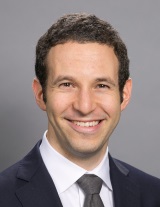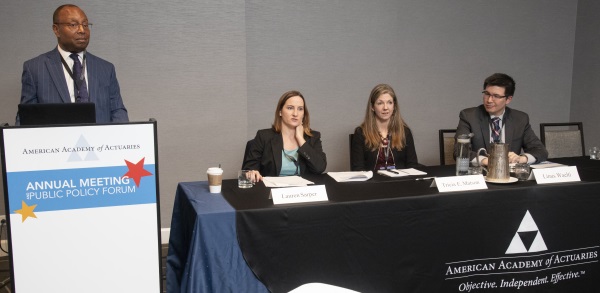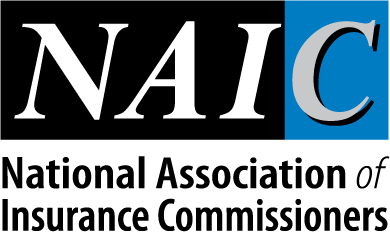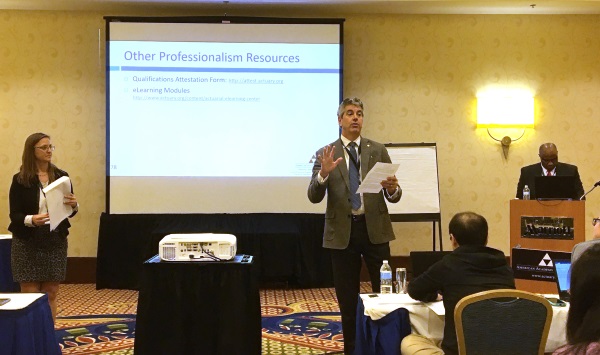Life Perspectives, Winter 2020
Vol 3 | No. 1
PBA Projections Practice Note Released
 Principle-Based Approach Projections Practice Note, which looks at questions and answers related to common practice for projecting future principle-based reserve (PBR) and risk-based capital (RBC) calculations. The PBA (principle-based approach) work group is a joint effort of the Academy’s Life Valuation Committee, the PBR Governance Work Group, and the Life Product Committee.
Principle-Based Approach Projections Practice Note, which looks at questions and answers related to common practice for projecting future principle-based reserve (PBR) and risk-based capital (RBC) calculations. The PBA (principle-based approach) work group is a joint effort of the Academy’s Life Valuation Committee, the PBR Governance Work Group, and the Life Product Committee.
Although this practice note focuses on projecting future VM-20 (Valuation Manual) reserves, there are sections applicable to VM-21 and other relevant frameworks. The considerations included for PBA projections could be relevant for projections such as pricing, asset adequacy testing, and business planning, it states.
One reason for creating this practice note was to develop a central resource in which to find PBA projection topics related to nested modeling techniques, asset projection topics, modeling simplifications, analysis and reporting, and governance and controls.
Life Perspectives asked Ben Slutsker, chairperson of the work group, some questions about the new practice note.
What was the impetus for creating this practice note? Did actuaries express issues with their projections?
The impetus for creating this practice note was to provide a centralized resource for actuaries looking to project future statutory reserves. As companies were figuring out how to calculate VM-20 reserves for point-in-time valuations, there appeared to still be significant ambiguity around how to project VM-20 reserves at future time points. I would hear various questions on these topics at forums such as the PBR Boot Camp and industry seminars. However, most of the answers provided to such questions were at a very high level or something along the lines of “do whatever you are doing for variable annuity AG43 calculations.”
At the same time, there were various articles and presentations that mentioned certain aspects of PBR projection issues, but no single centralized repository to address topics specifically related to projecting future PBR reserves. This was not only the case for VM-20, but also for variable annuity reserves, which were simultaneously coming back into the regulatory spotlight due to VM-21 and C3 Phase II revisions.
I ended up speaking with [Life Valuation Committee Chairperson] Jason Kehrberg about this topic and we both agreed it would be great for the Academy to introduce a practice note that could be the go-to reference for a lot of these questions. We also thought it would serve as a complement to the Academy VM-20 practice note, which is a wonderful resource for understanding VM-20 point-in-time valuations.
What does the practice note seek to do? How will it assist actuaries?
This practice note seeks to provide a set of common questions and answers related to the topic of projecting future principle-based reserves at future time periods. We think it will be able to assist actuaries who are projecting reserves for the purposes of pricing and business forecasting, among other purposes.
In particular, the practice note discusses situations in which a certain assumption-set is required for broader projection purpose, and a different assumption-set is required for regulatory purposes within that projection. We call the projections associated with these assumption-sets the “outer loop” and “inner loop,” respectively. When actuaries encounter situations where an “outer loop” and “inner loop” are applicable, rather than trying to reinvent the wheel, we thought it would be helpful to have a resource available describing common practices.
What are some typical scenarios it covers?
Typical cases that the practice note covers are pricing products that require VM-20 and VM-21 reserves. In addition, business forecasting for PBR business is also relevant. In addition to VM-20 and VM-21 reserves, the practice note describes topics that may also be applicable to economic and risk-based capital.
Within the projection of future PBR reserves, some more specific examples include:
- Mortality Improvement—Reflecting future mortality improvement in a broader projection purpose, but not within the VM-20 calculation (which prohibits future mortality improvement).
- Economic Scenarios—Using a company best estimate economic scenario for a broader projection, but reflecting the prescribed economic scenarios within the projected VM-20/VM-21 reserves.
- Margins—Reflecting margins on PBR prudent estimates that are expected to vary based on future valuation dates. One example is VM-20 mortality credibility, which could build up over time for newer segments, and therefore have a reduced margin or extended industry grade-in period.
Whom would you recommend this practice note to?
I would recommend the practice note to any actuaries who operate actuarial models consisting of future PBR projections. This includes actuaries involved in pricing, asset adequacy testing, and business planning. It can be used to look up common questions and answers that actuaries run into, whether applicable to VM-20, VM-21, or other principle-based calculations. The practice note is fairly technical and intended for actuaries familiar with reserve calculation details, as opposed to broader senior management or non-actuaries.
Do you anticipate this practice note will evolve over time as you receive feedback from actuaries?
While there may not be continuous annual updates to the practice note, it is possible that there will be future iterations as feedback is provided by industry practitioners. We certainly encourage actuaries who encounter issues not addressed in the practice note to reach out to the Life Practice Council—if enough items are communicated, this may warrant future updates. In particular, the practice note may need to address modifications to VM-20/VM-21 or new emerging regulatory frameworks, such as fixed annuity PBR or principle-based capital calculations.
PBR Boot Camp Covers Key Life Topics

Rachel Hemphill of the Texas Department of Insurance addresses a session
A capacity crowd attended Academy’s latest PBR Boot Camp in Austin, Texas, in December, which covered aspects of principle-based reserving (PBR) for life actuaries. The three-day seminar featured more than 20 dynamic, interactive sessions and was led by an expert faculty experienced with the new PBR procedures.
New in this iteration of the Boot Camp was a robust discussion and updates on the recently adopted changes to variable annuity valuation. Overall, attendees received targeted information and participated in intensive, focused discussion groups, sharing insights and learning from others’ experience of PBR in their practice.
Annual Meeting Life Sessions Cover Key Issues; Podcast Shares Highlights
Life practice-area breakout sessions at the Academy’s Annual Meeting and Public Policy Forum in November covered a range of key topics, including macroprudential issues, combination products, and modeling and new data sources. Highlights from the event were featured in an episode of “Actuary Voices,” the Academy’s new podcast series. The 2020 Annual Meeting and Public Policy Forum will be held Dec. 5–6 in Washington, just days after the 2020 election.
Macroprudential Issues

Johnson (at podium) and panelists at the macroprudential issues session
After the 2008 financial crisis, insurance regulators recognized the need for tools to identify systemic risk. This breakout session provided a background on federal and NAIC issues and a discussion of current initiatives designed to enhance these tools. Jeff Johnson, chairperson of the Academy’s Macroprudential Task Force, moderated this session.
Panelists Tricia Matson of Risk and Regulatory Consulting, Linus Waelti of New York Life, and Lauren Eardensohn Sarper of Prudential Life discussed the Dodd-Frank Act of 2010, which established the Financial Stability Oversight Council (FSOC) and the NAIC Solvency Modernization Initiative and Macroprudential Initiative. The discussion of current oversight initiatives revolved around the use of liquidity stress testing and its framework, which is currently being refined and discussed at the NAIC. A formal exposure of the liquidity stress test framework is expected to be released at some point this year to the general public for comments.
Panelists also touched on the objectives of and general approach to the framework and engaged in an in-depth conversation regarding the factors impacting asset, liability, operating and stressed liquidity, as well as current own-risk and solvency assessment (ORSA) requirements.
Combination Products
People are living longer and are at risk of outliving their savings, contributing to financial challenges later in life as their health deteriorates. This session explored the emerging use of combination products, in which a life insurance policy is combined with long-term care insurance (LTCI). One example of the need for LTCI can be noted in the costs for nursing homes, which average $8,517 a month.
“Only 10 percent of the people that need LTC are buying it,” panelist Parag Shah of Pacific Life noted. At the same time, the stand-alone LTCI market has shrunk by nearly 80 percent in the past 15 years. Panelists Carl Friedrich of the Academy’s LTC Combo Valuations Work Group and Shah discussed the various LTC products currently on the market, including the pros and cons of each, such as the issues and opportunities the products present to a policyholder.
While stand-alone LTCI is the most cost-effective solution for LTC needs, rate increases have resulted in decreased sales and fewer carriers offering the product. Combination products have gained a market appeal by providing a solution for when LTC benefits are not used and provide stronger rate guarantees. The speakers also discussed the tax implications for combination products and how principle-based reserving (PBR) affects them.
Modeling and New Data Sources

Stehno (at podium), Andrews, and Ferris at the modeling
and new data sources session
As new technologies emerge and new life products are created to adapt to the changing market, actuaries need to remain in the loop as the environment changes. The session began with the simple question: “Can actuaries be data scientists?” and then explored modeling in the age of the data scientists by first discussing predictive modeling. Key drivers of change were analyzed to focus on how competition, health care costs, and insurtech are impacting the market.
As insurance companies continue to invest money in startups, insurtech is causing disruption in the marketplace. During the session, speakers Dorothy Andrews, chairperson of the Academy’s Data Science and Analytics Committee, and Chris Stehno with Deloitte discussed potential scenarios in which actuaries and data scientists may be involved in a dilemma with respect to their modeling. Furthermore, the session focused on the use of external data sources, as well as the regulatory challenges actuaries and data scientists face as state jurisdictions continue to ban the use of external data for underwriting in life insurance.
The session concluded by exploring how lifestyle, behavioral, and environmental data impact the ways in which insurance companies analyze health risks, and how companies are adapting to new mobile technologies that can monitor health. This has led some companies to stop underwriting traditional life insurance and instead only sell interactive policies that track fitness and health data through wearable devices and smartphones. Andy Ferris, an Academy board member and a member of the Academy’s Data Science and Analytics Committee, moderated.
Academy Presents at NAIC Fall Meeting
 Academy leadership, volunteers, and staff presented at the NAIC Fall 2019 National Meeting, held in December in Austin, Texas, addressing various life topics in addition to health, casualty, and professionalism.
Academy leadership, volunteers, and staff presented at the NAIC Fall 2019 National Meeting, held in December in Austin, Texas, addressing various life topics in addition to health, casualty, and professionalism.
The Council on Professionalism gave updates to NAIC’s Life Actuarial Task Force (LATF) and other actuarial task forces, and Academy representatives including President D. Joeff Williams gave presentations at the Academy-hosted professionalism breakfast for regulators on Dec. 7, covering a variety of topics.
Academy Life Practice Council volunteers gave a number of public policy presentations to LATF, including on the treatment of valuation interest rates for payout annuities with non-level payments and approaches for adjustment to valuation interest rates for payout annuities; the proposed timeline and approach for the development of a principle-based reserving (PBR) framework for non-variable annuities; Academy PBR resources; and more.
Presentations to LATF included:
- An update from the Annuity Reserves Work Group on Preliminary Framework Elements for Non-Variable Annuity PBR;
- An update on the Yearly Renewable Term (YRT) Field Test;
- An update from the Standard Valuation Law (SVL) Interest Rate Modernization Work Group;
- The Life Reserves Working Group gave an update on PBR Treatment for Individually Underwritten Group Insurance;
- A discussion of considerations for changes to the Life Mortality Improvement Factor Process by the Academy Life Mortality Improvements Subgroup and the Society of Actuaries’ (SOA) Preferred Mortality Project Oversight Group (Joint Committee);
- An update from the Academy PBR Governance Work Group;
- A discussion of the Valuation Basic Table (VBT) and expiring experience, and comments received on Amendment Proposal Form (APF) 2019-56; and
- Also, the C-2 Work Group provided an update on the C-2 Mortality Overall Approach to NAIC’s Life Risk-Based Capital (E) Working Group.
For a full recap of all NAIC presentations, see the post-NAIC Academy alert. Also, the Academy will host a post-NAIC webinar covering life issues from the meeting on DATE HERE; to register, click here.
Attendees Earn Valuable CE at Sold-Out LHQ Seminar

Williams presides at a Nov. 11 professionalism session
A capacity crowd of more than 100 people attended the Academy’s sold-out Life and Health Qualifications Seminar Nov. 10–14 in Arlington, Va. The seminar and its interactive sessions are highly valued by attendees, with many returning every few years to brush up on skills. Attendees gained required basic education and continuing education to be qualified to sign statements of actuarial opinion (SAOs) for NAIC Life and Health annual statements.
The seminar is an effective way to earn continuing education credits under the U.S. Qualification Standards for those who already have the basic education needed to issue such SAOs. Academy President D. Joeff Williams chaired the committee that organizes this seminar.
In This Issue
The NAIC Valuation Analysis (E) Working Group (VAWG) released a review of the 2018 VM-20 Reserve Supplements and the Principle-Based Reserve (PBR) Actuarial Reports filed for calendar year end 2018; and voted to release the 2018 Principle-Based Reserves (PBR) Review Report. Read the Academy alert.
The New York Senate referred a bill to the Committee on Insurance in January that would amend current insurance law by allowing principle-based reserving for individual and group life insurance policies and annuity contracts.
A bill was introduced in the Vermont Senate in January that prohibits life insurance companies from utilizing or requiring genetic testing information of an individual when issuing policies or policy renewals and setting insurance rates.
A bill was introduced in the Arizona Senate in January that would prohibit discrimination of life insurance rates between individuals of the same class and equal expectation of life.
A bill was introduced in the New Hampshire Senate in January that would make significant changes to the state’s life insurance laws including the beneficiary’s primary claim to the proceeds of a life insurance policy, which would allow a charitable organization to be a designee as the beneficiary of a life insurance policy.
The New York Assembly is considering a bill, which passed the New York Senate, that would prohibit insurers from denying life insurance to individuals who have been prescribed medication used to block the effects of opioids.
The Michigan Legislature passed a bill, subsequently signed by the governor in January, that removes a provision that currently exempts certain insurers from the requirement to establish reserves using a principle-based valuation and valuation manual requirements that meet certain conditions in Code and deletes the provision that the Valuation Manual adopted by the NAIC are the minimum standard of valuation required.

Life and Health Law Manual Available
The Life and Health Valuation Law Manual contains information to help appointed actuaries know the requirements of the NAIC model Standard Valuation Law and the Model Actuarial Opinion and Memorandum Regulation. It includes a concise summary of the valuation laws (and NAIC regulations) of all 50 states, the District of Columbia, and Puerto Rico. Order today.
ThinkAdvisor story on the SECURE Act passed by Congress and signed by President Trump in December included comments from Academy Senior Pension Fellow Linda K. Stone on the lifetime income and other aspects of the legislation.
A report published by JD Supra and Lexology highlighted the Academy’s presentations at December’s NAIC Fall 2019 National Meeting in Austin, Texas.
A law firm article highlighting activity from the NAIC meeting, also published by Lexology (subscriber-only), noted the Academy’s work with the NAIC’s Longevity Risk (A/E) Subgroup.
